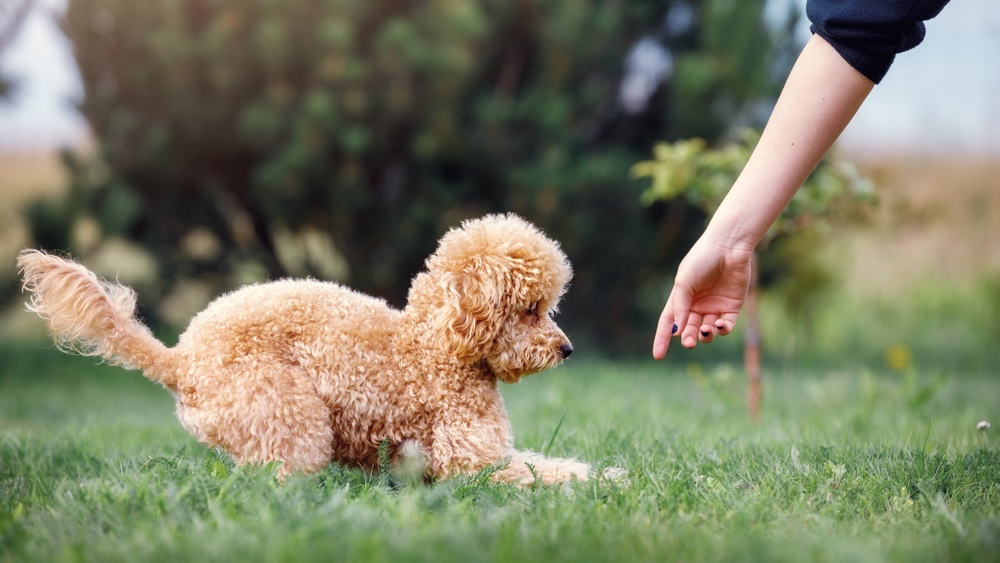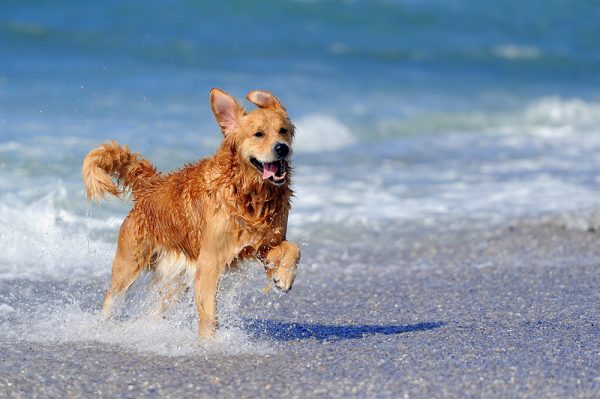In this article
View 2 More +Toy Poodles are just scaled-down versions of their larger counterparts, and they’re one of the easiest breeds to train. These little superstars are famous for their looks, but a well-trained Toy Poodle can even be used as a service dog for people who need support and are often chosen as a therapy dog whose job it is to visit those in hospitals and hospices.
Because of their intelligence, however, the Toy Poodle will need plenty of mental stimulation, but not as much physical stimulation as Standard Poodles. An under-stimulated or bored Toy Poodle can bark incessantly and even become destructive out of boredom.
A well-trained Toy Poodle is a happy one, so read on to learn how to train a Toy Poodle with these vet-reviewed tips and tricks.

Preparing to Train
When beginning your Toy Poodle training, setting goals is important. For example, do you want to complete basic training with your pup, or are you hoping to teach them more advanced tricks? Having a plan in mind when you begin can keep training smooth and keep you both calm, as well as give you something to celebrate once your dog gets it right!
Learning what motivates your Toy Poodle is another crucial step before training. Some dogs are toy-motivated, meaning a new toy will be the ultimate reward for completing a task, and some are treat-motivated. Learning your Poodle’s motivator will ensure they enjoy the training sessions, as you can use it as a reinforcer for desired behavior.


Before You Start
- Gather all your materials and pick a place where you and your dog feel calm and comfortable.
- If your Toy Poodle is conditioned to use a clicker, click it, and then give your Poodle a treat to let them know to expect it.
- Grab your reinforcer (treats, toys, etc.), and make sure the place you pick to begin your training is quiet and free from distractions.
When selecting words to use for your commands (“sit” or “down”), being consistent and using the same word and tone each time is key to your dog picking up the trick quickly, which shouldn’t be hard for a Toy Poodle. Try not to use command words that are similar to one another, like “down” and “lay down,” and don’t change the word halfway through training since it can confuse your pup.

The 5 Tips for Training a Toy Poodle
1. Start Simple
When it comes to Toy Poodle training, starting with simple but useful commands such as “sit,” “stay,” and “down” can not only be a neat party trick but may well save your pet’s life. For example, a well-trained “sit” can make crossing busy roads much safer, as will a “stay” if you need your Poodle to stay put.
The Poodle’s higher intelligence will make training these commands easy; the average Poodle takes as little as five repetitions of a command to master it. However, their intelligence may mean they get bored more quickly, so keep this in mind when planning your sessions.
To teach a command, ensure you have everything you need and that your training area is free of distractions. Get your Toy Poodle’s attention, and if they’re conditioned to a clicker, click and treat to let them know it’s time to learn.
Hold a treat directly above your Poodle’s nose and slowly move it back over their head. They should follow it and eventually sit on their hind legs and bottoms in the classic “sit” position. Once they do, click (if using a clicker) and offer a treat, saying the “sit” command in a loud, clear voice
Do this a few more times, making sure to use the same command every time your dog correctly sits on the ground. After your Toy Poodle gets the hang of the command that you’re trying to teach, it’s time for them to master it.

2. Master the Command
Every Toy Poodle will need patience and repetition to be trained successfully. Repeating the process, rewarding the command, and saying your chosen word in a clear voice will help your Poodle make the association. This helps them understand that if they do this action when you say this word or do this movement, they’ll get something nice!
Once you’ve laid the foundations for the commands you want to teach your Toy Poodle (such as sit, down, stay, etc.), you can experiment with routines and orders. If you want your dog to stay after they sit, for example, teaching in this order will help them learn the routine and will ultimately make training smoother for you both going ahead.
However, once your Toy Poodle knows the commands consistently, you can play around with the order of commands to reinforce their attention rather than have them learn a set routine. This exercise helps to increase their motivation and prevents boredom, as dogs enjoy variability, especially very intelligent dogs like a Toy Poodle.
Taking your time with each command and ensuring your Toy Poodle understands what they need to do to be rewarded is the key to successful training, and this, in turn, will lead to our next point in how to train your Poodle: practice.
3. Practice, Practice, Practice
You’ve taught your Poodle the basic commands you want them to learn, and you’re confident they know each command well. So, what’s the next step? Practice. Practicing with your Toy Poodle in different environments and situations will help them to know not just the very specific “stay while I fill your bowl” command but will expand the idea to include “stay while the vet clips your toenails.” Or at least, that’s what to aim for.

4. Time to Test
The last facet of training for any dog is to put its training to the test. Using commands in different environments, in a different order, or using it in various situations will all test the depth of your Toy Poodle’s understanding of their training.
Remember that your dog will always try their very best when training with you, so don’t feel disheartened if their perfect “down” at home doesn’t yet apply to the table laden with hotdogs.
5. Mastery
Once your Toy Poodle has learned the training commands and has been consistently responding to you at any time with perfect form, you’ve mastered the tricks and actions you’ve wanted them to do, and it’s time for something new.
Poodles are a highly intelligent breed, so adding additional commands and actions into their training will keep them sharp and entertained and continually build the bond between you.
Testing your Poodle’s grasp on their training is an excellent way to ensure mastery. Using the commands in daily life and not always rewarding the same way if they get it right will keep the motivation to get the treat, which is as important as the treat itself. Having your dog perform the task a few times before giving a treat (and lots of fuss) can be a good way to keep your Poodle’s attention. Offering a jackpot here and there intertwined with lots of cuddles, a word of praise, the chance to play with their favorite toy, and sometimes two instead of one treat can help avoid predictability and keep their interest.


Other Important Considerations
A few more tips and tricks can be used when training your Toy Poodle to help the process go as smoothly as possible while keeping it enjoyable and getting great results.
Don’t Be Disheartened
It can be disappointing when you’ve been hearing all about how intelligent Toy Poodles are and how quickly they’ll pick up tricks, and all your Poodle has been doing is politely refusing to cooperate.
It can be overwhelming if a large amount of training is being undertaken at once. Don’t be disheartened by this, as most dogs will more than happily train with you and may need a bit of mental rest. Keep going, give plenty of treats and praise, and don’t give up; your Toy Poodle will perform commands perfectly in no time.
Don’t Allow Frustration to Get in the Way
Leading on from the previous point, it can also be incredibly frustrating if your dog is seemingly refusing to cooperate or is not listening at all. While this is understandable, try to see the training session from your Toy Poodle’s perspective. For example, are the training sessions long? Are multiple tricks being taught at the same time? Is the area you’re training in loud, busy, and full of delicious smells (such as a city park)?
Try to perform your training in a quiet, relatively empty space you both know well. Distractions in cities, busy areas, and sensory overload can prove too much for your dog, and you’ll find them sniffing out other interesting sights rather than taking you seriously.
If you find yourself getting frustrated, stop the training and calm down. Never shout at or scold your dog for not getting the training, as this will make them not want to perform it at all in fear of being yelled at again.

Enjoy Yourself
The last point is the most important one, and that is to have fun. Training with your Toy Poodle is an excellent bonding opportunity for you both, and because of the Poodle’s intelligence and grace, the possibilities are endless when building on your training. If you feel your Poodle isn’t enjoying itself or is getting stressed at any point, stop and carry on the training another day.

Conclusion
Toy Poodles are intelligent and sweet little dogs bursting with energy and charm. Toy Poodle training them can be challenging, as they can get bored with the same thing being repeated, but they typically pick up training lightning fast, enjoying every minute.
The keys to successful training with your Toy Poodle are to be consistent and patient, practice, and, most importantly, have fun.
- You may be interested in: How to Train a Dog to Stop Barking: 5 Vet-Approved Tips
Featured Image Credit: Linas T, Shutterstock




















